
A kilt is a garment resembling a wrap-around knee-length skirt, made of twill-woven worsted wool with heavy pleats at the sides and back and traditionally a tartan pattern. Originating in the Scottish Highland dress for men, it is first recorded in the 16th century as the great kilt, a full-length garment whose upper half could be worn as a cloak. The small kilt or modern kilt emerged in the 18th century, and is essentially the bottom half of the great kilt. Since the 19th century, it has become associated with the wider culture of Scotland, and more broadly with Gaelic or Celtic heritage.

An apron is a garment that is worn over other clothing to cover the front of the body. They may have several purposes, typically as a functional accessory that protects clothes and skin from stains and marks. However, other types of aprons may be worn as a decoration, for hygienic reasons, as part of a uniform, or as protection from certain dangers such as acid, allergens or excessive heat. It can also be used at work stations to hold extra tools and pieces or protect from dust and unwanted materials.

A brooch is a decorative jewellery item designed to be attached to garments, often to fasten them together. It is usually made of metal, often silver or gold or some other material. Brooches are frequently decorated with enamel or with gemstones and may be solely for ornament or serve a practical function as a clothes fastener. The earliest known brooches are from the Bronze Age. As fashions in brooches changed rather quickly, they are important chronological indicators. In archaeology, ancient European brooches are usually referred to by the Latin term fibula.

The sporran, a traditional part of male Scottish Highland dress, is a pouch that functions as a pocket for the kilt. Made of leather or fur, the ornamentation of the sporran is chosen to complement the formality of dress worn with it. The sporran is worn on a leather strap or chain, conventionally positioned in front of the groin of the wearer.
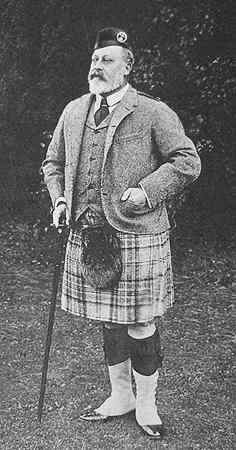
Highland dress is the traditional, regional dress of the Highlands and Isles of Scotland. It is often characterised by tartan. Specific designs of shirt, jacket, bodice and headwear may also be worn along with clan badges and other devices indicating family and heritage.

Fashion in the period 1550–1600 in European clothing was characterized by increased opulence. Contrasting fabrics, slashes, embroidery, applied trims, and other forms of surface ornamentation remained prominent. The wide silhouette, conical for women with breadth at the hips and broadly square for men with width at the shoulders had reached its peak in the 1530s, and by mid-century a tall, narrow line with a V-lined waist was back in fashion. Sleeves and women's skirts then began to widen again, with emphasis at the shoulder that would continue into the next century. The characteristic garment of the period was the ruff, which began as a modest ruffle attached to the neckband of a shirt or smock and grew into a separate garment of fine linen, trimmed with lace, cutwork or embroidery, and shaped into crisp, precise folds with starch and heated irons.
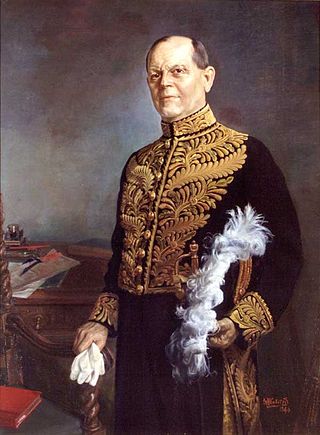
Court uniform and dress were required to be worn by those in attendance at the royal court in the 19th and early 20th centuries.

The modern, tailored kilt which is ubiquitous at Highland games gatherings around the world has associated with it an evolving style of wear. This style includes the accessories and other accoutrements which are typically worn with it. In this sense, it is very much like other items of the fashion world.

The modern Irish Army uniform is based on the layer principle, and is designed to provide soldiers in the Irish Army with the right degree of protection for any operational environment.

A full plaid, or just a plaid, is a long piece of tartan fabric, most often worn as part of a Highland dress. It usually matches the tartan of the kilt. A modern full plaid is pleated the whole way, with half of its length sewn shut. Its length is about twice the distance from the ground to the wearer's shoulder.
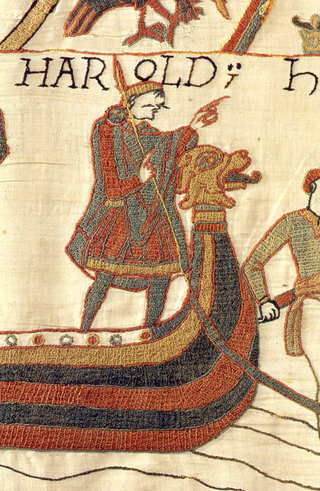
Anglo-Saxon dress refers to the clothing and accessories worn by the Anglo-Saxons from the middle of the second century to the eleventh century. Archaeological finds in Anglo-Saxon cemeteries have provided the best source of information on Anglo-Saxon costume. It is possible to reconstruct Anglo-Saxon dress using archaeological evidence combined with Anglo-Saxon and European art, writing and literature of the period. Archaeological finds have both supported and contradicted the characteristic Anglo-Saxon costume as illustrated and described by these contemporary sources.

Early medieval European dress, from about 400 AD to 1100 AD, changed very gradually. The main feature of the period was the meeting of late Roman costume with that of the invading peoples who moved into Europe over this period. For a period of several centuries, people in many countries dressed differently depending on whether they identified with the old Romanised population, or the new populations such as Franks, Anglo-Saxons, Visigoths. The most easily recognisable difference between the two groups was in male costume, where the invading peoples generally wore short tunics, with belts, and visible trousers, hose or leggings. The Romanised populations, and the Church, remained faithful to the longer tunics of Roman formal costume, coming below the knee, and often to the ankles. By the end of the period, these distinctions had finally disappeared, and Roman dress forms remained mainly as special styles of clothing for the clergy – the vestments that have changed relatively little up to the present day.

Clothing in ancient Greece refers to clothing starting from the Aegean bronze age to the Hellenistic period. Clothing in ancient Greece included a wide variety of styles but primarily consisted of the chiton, peplos, himation, and chlamys. Ancient Greek civilians typically wore two pieces of clothing draped about the body: an undergarment and a cloak. The people of ancient Greece had many factors that determined what they wore and when they wore it.
The Medieval period in England is usually classified as the time between the fall of the Roman Empire to the beginning of the Renaissance, roughly the years AD 410–1485. For various peoples living in England, the Anglo-Saxons, Anglo-Danes, Normans and Britons, clothing in the medieval era differed widely for men and women as well as for different classes in the social hierarchy. The general styles of Early medieval European dress were shared in England. In the later part of the period, men's clothing changed much more rapidly than women's styles. Clothes were very expensive and both the men and women of lower social classes continued also divided social classes by regulating the colors and styles these various ranks were permitted to wear. In the early Middle Ages, clothing was typically simple and, particularly in the case of lower-class peoples, served only basic utilitarian functions such as modesty and protection from the elements. As time went on the advent of more advanced textile techniques and increased international relations, clothing gradually got more and more intricate and elegant, even with those under the wealthy classes, up into the renaissance.
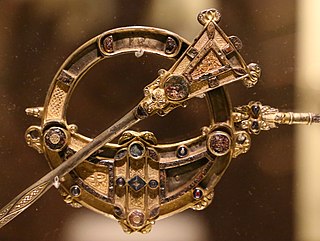
The Celtic brooch, more properly called the penannular brooch, and its closely related type, the pseudo-penannular brooch, are types of brooch clothes fasteners, often rather large; penannular means formed as an incomplete ring. They are especially associated with the beginning of the Early Medieval period in Ireland and Britain, although they are found in other times and places—for example, forming part of traditional female dress in areas in modern North Africa.
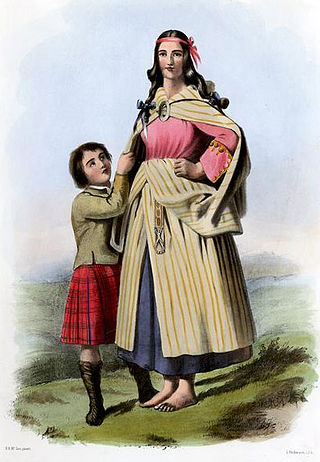
An arisaid is a draped garment historically worn in Scotland in the 17th and 18th century as part of traditional female Highland dress. It was worn as a dress – a long, feminine version of the masculine belted plaid – or as an unbelted wrap. An earasaid might be brightly coloured or made of lachdann wool. Some colours were more expensive than others. The garment might be single-coloured, striped, or tartan – especially of black, blue, and red stripes on white. White-based earasaid tartans influenced later dance and sometimes dress tartans, as well as household-item tartans in a style called "barred blanket" tartan.

A car coat is an outer garment originally made to be worn by automobile drivers and passengers. First designed to provide maximum warmth and coverage, over time it became a much shorter garment. Today it describes a coat that typically ends at mid thigh. It is worn by both men and women.

Mughal clothing refers to clothing worn by the Mughals in the 16th, 17th and 18th centuries throughout the extent of their empire. Much of them were already being used in the past centuries before their arrival in Indian subcontinent. It was characterized by luxurious styles and was made with muslin, silk, velvet and brocade. Elaborate patterns including dots, checks, and waves were used with colors from various dyes including cochineal, sulfate of iron, sulfate of copper, and sulfate of antimony were used.

Scottish jewellery is jewellery created in Scotland or in a style associated with Scotland, which today often takes the form of the Celtic style. It is often characterised by being inspired by nature, Scandinavian mythology, and Celtic knot patterns. Jewellery has a history in Scotland dating back to at least the Iron Age.



















